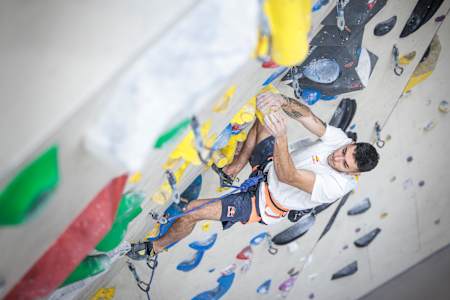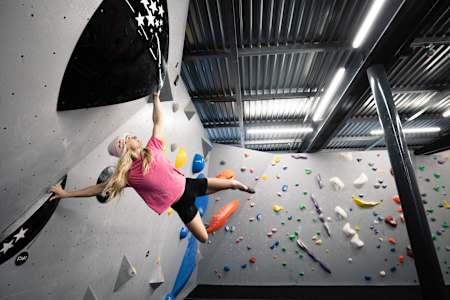
Bouldering
The differences and similarities between bouldering and sport climbing
Master the ascent as we explore two of the most popular forms of climbing and explain the various differences between bouldering and sport climbing.
To those who are new to the world of climbing, deciding which type to try may be your first challenge. Therefore it's important to know the difference between the most popular forms, which are bouldering and sport climbing. Both can be extremely fun but they require different skills and hit different muscle groups.
These two forms of climbing both involve scaling vertical terrain but it is how that ascent is achieved that makes all the difference.
01
Sport climbing
Sport climbing is done both on artificial walls and on rocks. It's practiced with ropes and harnesses on walls with permanent anchors, which are known as plates. It's also performed in pairs as you need a climber and a belayer. The latter is someone who controls the safety rope for a climber and can be relied upon to catch a fall every time the need arises.
The wall anchors have been strategically placed along the route and allow climbers to belay as they ascend, always guaranteeing the climber's safety. Once a climber reaches a plate, they secure the rope to it using a carabiner. As the climber advances along the route, they unclip the rope from the previous plate and secure it to the next one as they continue the ascent. When done in competition, sport climbing is called lead climbing. Red Bull Dual Ascent is a good example of a Sport climbing competition.

27 min
Elite climbers compete at Verzasca Dam
Look back at the best bits as 24 of the world’s best climbers go head to head at Red Bull Dual Ascent 2023.
Characteristics of sport climbing:
- Permanent anchors (plates).
- Use of ropes and carabiners to belay as you climb.
- Combines strength, endurance and technical skill.
- Routes vary in difficulty and length, testing the physical and mental endurance of climbers.
- Routes are graded using a grading system that varies by country or region.
02
Bouldering
Bouldering (also called block climbing) is practiced on short stretches of rock faces or small walls, without the use of ropes, harnesses or belay devices. It is a type of climbing that focuses on solving problems (or boulders) that require strength, technique and agility. Unlike sport climbing, where climbers face longer, continuous routes, in bouldering the objective is to solve specific moves on a stretch of wall up to six meters high.
In bouldering, the climber moves both in ascent and in horizontal movements (traverse), with extreme difficulty prevailing during very short routes, which makes falls quite common. However, due to the low height of the sections, the risk of serious injury is low.
Even so, as protection, a portable mat called a crash pad is generally used to cushion possible falls. Thus, while the climber tackles the wall, another companion (called a porter" stands guard under the wall to take care of the athlete in case of a possible fall.
"In bouldering, the most important thing is strength and technique," says Spain's number one men's sport climber Alberto Ginés Lopez.
Characteristics of bouldering:
- It tends to be practiced on short sections of rock walls without ropes or harnesses.
- The wall sections do not usually exceed six meters in height.
- Its objective is focused on solving problems or boulders, generally in a single movement.
- It requires explosive movements, maximum strength and agility.
- A portable mat is used as protection to cushion possible falls.
The differences between sport climbing and bouldering
Sport climbing
Bouldering
Movements
Sustained and constant
Explosive and fast
Routes
Longer with permanent anchorages
Short stretches without ropes
Technique
Mastery of different climbing styles
Focus on grip and precise movements
Force
Strain on the forearm flexors
Grip strength
03
I want to try it. What do I need?
As in any sport, having the right equipment is essential to get started in climbing. To take the first steps, the best place to start is through a climbing club as they will have easy access to some of the fundamental safety tools such as ropes, harnesses, helmets and magnesium powder.
It is also advisable to invest in appropriate climbing shoes. These come in various shapes and sizes so the choice will depend on climbing styles and foot shapes. As for the size, generally, your climbing shoe size is smaller than your usual street shoe size for a better feel of the footholds.
As far as clothing is concerned, it should not get in the rope so you don't want anything particularly baggy. It should be breathable, absorb sweat and dry quickly in order to maintain warmth and comfort while climbing. It's also good to bring a change of clothes if you are climbing outside as the weather can quickly change.






